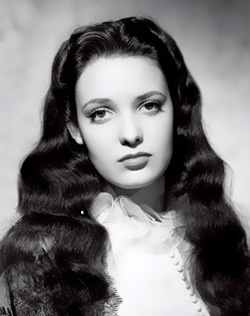 Being beautiful was Linda Darnell’s curse. She was an emotionally intuitive actress, but almost from the beginning of her career, she was typecast because of her looks. Add in alcohol problems and a series of tortured relationships, and you have the recipe for a full-tilt Hollywood tragedy.
Being beautiful was Linda Darnell’s curse. She was an emotionally intuitive actress, but almost from the beginning of her career, she was typecast because of her looks. Add in alcohol problems and a series of tortured relationships, and you have the recipe for a full-tilt Hollywood tragedy.
She was born Monette Eloyse Darnell in Dallas, Texas on October 16th, 1923 to a postal clerk named Calvin Darnell and his wife Pearl. Hailing from rural Tennessee, the fiercely ambitious Pearl had sought unsuccessfully to become an actress, only to end up as a domestic servant saddled with five children. Determined that one of her children would succeed where she had failed, she focused all her energies on her beautiful second daughter. For all intents and purposes, Monette was groomed from youth to be a star. She was enrolled in music, dance, drama, and elocution lessons while still a child, and her mother entered her into an unending series of beauty and talent contests.
She started making appearances in movies in 1939 when she was still just fifteen years old (though by this time the studio, 20th Century Fox, had changed her name to Linda and tacked on two years to her official age). Already fully possessed and startlingly beautiful, she almost immediately became a star. She made four films cast opposite swarthy Tyrone Power and specialized in fresh-faced brides and ingénues.
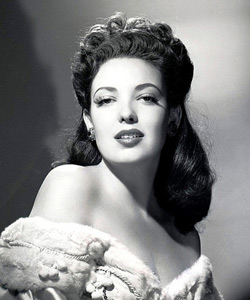 Then, in 1943, her surprise marriage to veteran cameraman Pev Marley (who was twice her age) threw her career into crisis. She was placed on suspension and relegated to small roles. During this period, she made a brief appearance as the vision of the Virgin Mary that appears to a young girl in 1943’s The Song Of Bernadette. In the studio system, however, actors were treated as commodities, and it didn’t take very long for 20th Century Fox to decide that its voluptuous, newly-married young actress would be better commoditized as a sex object. Henceforth, she would play bad girls. As Darnell’s biographer Ronald L. Davis would note, “Beyond question Linda’s being cast as a slut rather than a virgin made her a more interesting property both for her studio and the gossip columnists.” Few actresses experienced the Virgin/Whore Complex in more literal terms than Linda Darnell.
Then, in 1943, her surprise marriage to veteran cameraman Pev Marley (who was twice her age) threw her career into crisis. She was placed on suspension and relegated to small roles. During this period, she made a brief appearance as the vision of the Virgin Mary that appears to a young girl in 1943’s The Song Of Bernadette. In the studio system, however, actors were treated as commodities, and it didn’t take very long for 20th Century Fox to decide that its voluptuous, newly-married young actress would be better commoditized as a sex object. Henceforth, she would play bad girls. As Darnell’s biographer Ronald L. Davis would note, “Beyond question Linda’s being cast as a slut rather than a virgin made her a more interesting property both for her studio and the gossip columnists.” Few actresses experienced the Virgin/Whore Complex in more literal terms than Linda Darnell.
In 1945, Darnell was cast in the role of a ruinously manipulative “dance hall girl” (which was 1945's term for “prostitute”) in John Brahm’s Hangover Square. She first appears on stage, singing to a bunch of drunks. After she meets a composer (Laird Creger), she asks someone, “Is he important?” Told that he is, indeed, quite important, she proceeds to squeeze him for free songs she can put in her act. What she doesn’t know is that the composer is a psychopath who murders people in moments of blackout delirium. This would not be the last time Darnell would play an ill-fated femme fatale.
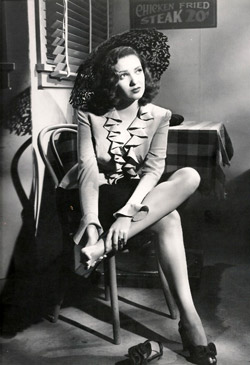 That same year, she gave her best noir performance in Otto Preminger’s Fallen Angel as Stella, the sexy waitress at a beachside greasy spoon diner. One day a smooth-talking drifter named Eric Stanton (Dana Andrews) blows in from the road. He thinks he can sweep her off her feet with some smooth talk, but there’s more to Stella than meets the eye. She’s been around the block. She’s heard Stanton’s line of bullshit before. He wants sex. She wants a future. Stanton promises her one and quickly deduces that the quickest way to buy Stella what she wants is to marry June (Alice Faye) the local church organist and steal her money.
That same year, she gave her best noir performance in Otto Preminger’s Fallen Angel as Stella, the sexy waitress at a beachside greasy spoon diner. One day a smooth-talking drifter named Eric Stanton (Dana Andrews) blows in from the road. He thinks he can sweep her off her feet with some smooth talk, but there’s more to Stella than meets the eye. She’s been around the block. She’s heard Stanton’s line of bullshit before. He wants sex. She wants a future. Stanton promises her one and quickly deduces that the quickest way to buy Stella what she wants is to marry June (Alice Faye) the local church organist and steal her money.
The film belongs to Darnell. It lingers on her earthy beauty, voluptuous figure, and big brown eyes. It’s in love with her legs, and it gives her a lot of caustic dialog to sink her husky voice into. The audience is as taken with Stella as Stanton is. She’s positioned in the film as something of a “bad girl,” but, in the screwy gender dynamics of the time, this only means that she is sexualized. Darnell was never better—sexy and angry and ultimately very touching, more of a lost soul than a bad girl.
In the later forties, Darnell’s popularity peaked. She was excellent as a gold digger in Joseph L. Mankiewicz’s A Letter To Three Wives (1949) and followed it up the next year with a strong performance in Mankiewicz’s No Way Out opposite Richard Widmark and Sidney Poitier (in his film debut).
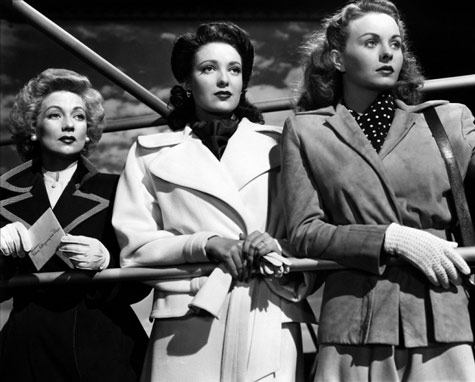
The good roles dried up fast, and by 1952, she was either headlining lifeless B-grade thrillers like Night Without Sleep or providing eye candy in pictures like Second Chance opposite Robert Mitchum. Another failed marriage followed, her drinking increased, and by the mid-fifties, her big screen career was all but over.
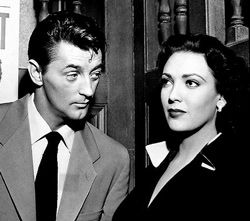 She married for a third time to a handsome airline pilot named Merle Robertson, who took control of her career and shuttled her into nightclub work. Darnell hated the demeaning gigs, and her drinking and depression increased. After a short stint in rehab, she returned home to find that Robertson had knocked up a younger woman and wanted a divorce. Broke and inconsolable, Darnell tried to kill herself.
She married for a third time to a handsome airline pilot named Merle Robertson, who took control of her career and shuttled her into nightclub work. Darnell hated the demeaning gigs, and her drinking and depression increased. After a short stint in rehab, she returned home to find that Robertson had knocked up a younger woman and wanted a divorce. Broke and inconsolable, Darnell tried to kill herself.
After that low point, she slowly began to fight her way back. She cut back on her drinking and went on the road with a traveling production of the play Janus—which turned out to be a success. She began to repair her estranged relationship with her daughter, Lola Marley. She made a final film appearance, in the B-Western Black Spurs.
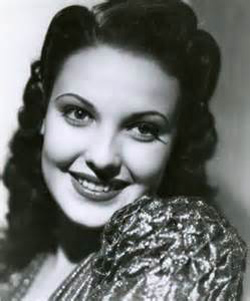 This brief, happy period ended on April 8th, 1965 when Darnell was caught in a fire at a friend’s apartment in Chicago. After suffering burns to ninety percent of her body, she lingered for an agonizing thirty-three hours before she died on April 10th. The misfortune of Linda Darnell seemed as pre-determined as a Greek tragedy. Raised by a mother obsessed with turning her into a star, she was pushed into the Hollywood star machine—a factory system that used her as a commodity and then tossed her aside once her economic worth had peaked.
This brief, happy period ended on April 8th, 1965 when Darnell was caught in a fire at a friend’s apartment in Chicago. After suffering burns to ninety percent of her body, she lingered for an agonizing thirty-three hours before she died on April 10th. The misfortune of Linda Darnell seemed as pre-determined as a Greek tragedy. Raised by a mother obsessed with turning her into a star, she was pushed into the Hollywood star machine—a factory system that used her as a commodity and then tossed her aside once her economic worth had peaked.
It’s a brutal story, but what remains of her is a cinematic legacy of images. To watch something like Fallen Angel or A Letter To Three Wives is to see the mystery of Linda Darnell alive and well, as beautiful and haunting as ever.
Read more from our Film Noir Collection.
Jake Hinkson, the Night Editor, is the author of The Posthumous Man.

Hollywood is full of sad stories and this is one of them. I never was a big fan, but she was very good in Fallen Angel, one of my favorite noirs.
I was unfamiliar with Linda Darnell’s work until last night, when I watched her in No Way Out. I was watching in tribute to Sidney Poitier but became intrigued by Darnell! Given the social norms of the 50s, is anyone aware of how Ms. Darnell and Mr, Poitier got along? Was she stigmatized or lauded for playing across from an African American co-lead? I read that NWO was banned in the South (no surprise) and censored in the North due to scenes of fighting between black and white ruffians.